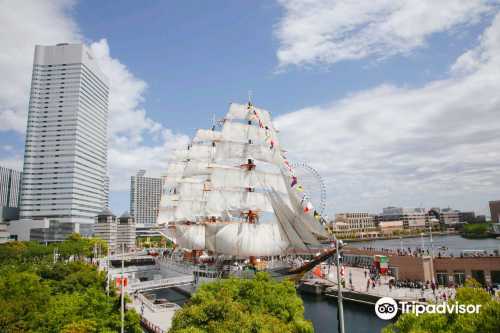Popular Trip Moments
Spring Outing to Satoyama Garden – A Floral Paradise | [Kamakura Alps: From the hidden areas of Kita-Kamakura, Yamanouchi, and Imaizumi to Nikaido. Sansaigaike Park, Inyo Falls, and Tenen Hiking Course] | Sankeien Garden Illumination ✨🌙 Enjoy the fantastic Japanese night view | Kamihoshigawa Snap 📷🏙️ A hidden photogenic spot | Yokohama Far East Village Hotel | Yamashita Park in Yokohama | Minato Mirai 21, Yokohama: A Seaside Journey Through Time and the Future | Habour view park in spring | Yokohama Chinatown Tianhou Temple | Spring Blooms at Yamashita Park🌷 | [Welcome spring at the Yokohama New Grand Hotel and Hikawa Maru, with cherry blossoms in full bloom, and Yamashita Park] | Afternoon tea love&table | Dockyard Garden | Minato Mirai Night Stroll Snapshots: Enchanting Scenery of Light and Shadow | Beautiful spots in Tokyo | 📍Sakuragicho Washington Hotel/Kanagawa | [Kanagawa] Relaxing retro cafe | Yokohama Sakuragicho Resol Hotel | 7-Day Japan Family Trip: A Super Detailed Guide | Yokohama/TOP-level oyster ramen. Packed with oysters. | Chasing Sakura at Yamashita Park Yokohama | Chasing Sakura at Ookagawa River | Chasing Sakura at Minato Mirai Yokohama | Chasing Sakura at Yokohama Prefecture | 🌸 Secret Cherry Blossom Viewing Spot in Yokohama | 📍Driveway | Sankeien Garden – "A Timeless Sakura Escape" | Tokyo is beautiful, but then I went here… | [Kanagawa/Chinatown] If you're looking for authentic Cantonese Chinese food, this is the place to go!! *Manchinro Main Branch* | [🇯🇵Yokohama] A day to enjoy the exotic atmosphere of Yokohama Chinatown and the winter seasonal tradition of Yokohama Christmas Market | 🛳️ Yokohama Day Tour|Cable Car・Red Brick Warehouse✨
Popular Travel Types
Recommended Attractions at Popular Destinations
Bangkok attraction near me | Manila attraction near me | Tokyo attraction near me | Taipei attraction near me | Hong Kong attraction near me | Seoul attraction near me | Kuala Lumpur attraction near me | Los Angeles attraction near me | Shanghai attraction near me | New York attraction near me | Shenzhen attraction near me | Osaka attraction near me | Singapore attraction near me | London attraction near me | Guangzhou attraction near me | San Francisco attraction near me | Beijing attraction near me | Macau attraction near me | Bali attraction near me | Jakarta attraction near me | Paris attraction near me | Ho Chi Minh City attraction near me | Istanbul attraction near me | Phuket attraction near me | Chicago attraction near me | Seattle attraction near me | Toronto attraction near me | Orlando attraction near me | Cebu attraction near me | Chiang Mai attraction near me
Popular Restaurants in Yokohama
CAMBUSA | Oshima Yokohama | Cafe Tosca | Nadaman Yokohama-Branch | Yokohama Nadamanhinkan | Ristorante Umiria | Saikoushinkan | Shigorokusaikan | Masago Saryo | Hard Rock Cafe Yokohama | PIER 21 | MILANO | GRILL | Queen Alice Yokohama | Chinese Restaurant Sai-Ryu | Sky Lounge - Bay View | Brasserie Milly La Foret | Coffee House The CAFE | Teppanyakisagami | Azamino Ukai-tei | Ocean Terrace | Bishokumaimon Yokohama | AFRO TACOS | Yugyoan Tankumakitaten | Ko-No-Hana | Charcoal Grill green BASHAMICHI | Nikitei | Revo Brewing | Bairin | Bar "Bay West" | Haraguro-Ya Yokohama
Popular Ranked Lists
Top 3 Local Restaurants in Hefeng | Top 4 Local Restaurants in Xinzheng | Top 10 Local Restaurants in Golmud | Popular Best Things to Do in Dongtai | Popular Luxury Hotels Near Toap | Top 9 Local Restaurants in Liuyang | Popular Best Things to Do in Tongdao | Popular Luxury Hotels Near Recreio dos Bandeirantes | Top 3 Local Restaurants in Chuzhou | Popular Luxury Hotels in Ramatuelle | Top 4 Best Things to Do in Daxin | Top 4 Best Things to Do in Sanjiang | Popular Luxury Hotels Near Nassau | Popular Best Things to Do in Ebian | Top 6 Local Restaurants in Huainan | Top 9 Best Things to Do in Liangshan Prefecture | Top 3 Best Things to Do in Yuyao | Top 5 Best Things to Do in Huludao | Top 6 Local Restaurants in Batam | Top 4 Best Things to Do in Pingyao | Popular Premium Hotels in Thap Put | Top 6 Local Restaurants in Deqin | Popular Best Things to Do in Leye | Popular Luxury Hotels Near Odiaxere | Popular Best Things to Do in Boluo | Top 9 Local Restaurants in Lushan Global Geopark | Top 3 Local Restaurants in Xinyuan | Top 5 Local Restaurants in Rugao | Popular Best Things to Do in Taoyuan | Popular Premium Hotels in Central Saanich
Payment Methods
Our Partners
Copyright © 2025 Trip.com Travel Singapore Pte. Ltd. All rights reserved
Site Operator: Trip.com Travel Singapore Pte. Ltd.
Site Operator: Trip.com Travel Singapore Pte. Ltd.





















